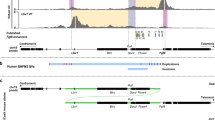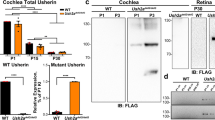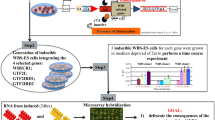Abstract
Analysis of classical mouse mutations has been useful in the identification and study of many genes. We previously mapped Sox18, encoding an SRY-related transcription factor1, to distal mouse chromosome 2 (ref. 2). This region contains a known mouse mutation, ragged (Ra), that affects the coat and vasculature3,4,5. Here we have directly evaluated Sox18 as a candidate for Ra. We found that Sox18 is expressed in the developing vascular endothelium and hair follicles in mouse embryos. Furthermore, we found no recombination between Sox18 and Ra in an interspecific backcross segregating for the Ra phenotype. We found point mutations in Sox18 in two different Ra alleles that result in missense translation and premature truncation of the encoded protein. Fusion proteins containing these mutations lack the ability to activate transcription relative to wild-type controls in an in vitro assay. Our observations implicate mutations in Sox18 as the underlying cause of the Ra phenotype, and identify Sox18 as a critical gene for cardiovascular and hair follicle formation.
This is a preview of subscription content, access via your institution
Access options
Subscribe to this journal
Receive 12 print issues and online access
$209.00 per year
only $17.42 per issue
Buy this article
- Purchase on Springer Link
- Instant access to full article PDF
Prices may be subject to local taxes which are calculated during checkout




Similar content being viewed by others
References
Hosking, B.M., Muscat, G.E.O., Koopman, P.A., Dowhan, D.H. & Dunn, T.L. Trans-activation and DNA-binding properties of the transcription factor, Sox-18. Nucleic Acids Res. 23, 2626–2628 (1995).
Greenfield, A., Dunn, T., Muscat, G. & Koopman, P. The Sry-related gene Sox18 maps to distal mouse chromosome 2. Genomics 36, 558–559 ( 1996).
Carter, T.C. & Phillips, R.J.S. Ragged, a semidominant coat texture mutant in the house mouse. J. Hered. 45 , 151–154 (1954).
Slee, J. The morphology and development of Ragged—a mutant affecting the skin and hair of the house mouse. I. Adult morphology. J. Genet. 55, 100–121 (1957).
Slee, J. The morphology and development of Ragged—a mutant affecting the skin and hair of the house mouse. II. Genetics, embryology and gross juvenile morphology . J. Genet. 55, 570–584 (1957).
Herbertson, B.M. & Wallace, M.E. Chylous ascites in newborn mice. J. Med. Genet. 1, 10– 23 (1964).
Wallace, M.E. Analysis of genetic control of chylous ascites in ragged mice. Heredity 43, 9–18 ( 1979).
Green, E.L. & Mann, S.J. Opossum, a semi-dominant lethal mutation affecting hair and other characteristics of mice. J. Hered. 52, 223–227 ( 1961).
Mann, S.J. The phenogenetics of hair mutants in the house mouse: Opossum and Ragged. Genet. Res. 4, 1–11 ( 1963).
Shalaby, F. et al. Failure of blood-island formation and vasculogenesis in Flk-1-deficient mice. Nature 376, 62 –66 (1995).
Fong, G.H., Rossant, J., Gertsenstein, M. & Breitman, M.L. Role of the Flt-1 receptor tyrosine kinase in regulating the assembly of vascular endothelium. Nature 376, 66– 70 (1995).
Iseki, S. et al. Sonic Hedgehog is expressed in epithelial cells during development of whisker, hair, and tooth. Biochem. Biophys. Res. Commun. 218, 688–693 ( 1996).
St-Jacques, B. et al. Sonic hedgehog signaling is essential for hair development . Curr. Biol. 8, 1058–1068 (1998).
Pingault, V. et al. SOX10 mutations in patients with Waardenburg-Hirschsprung disease. Nature Genet. 18, 171– 173 (1998).
Wagner, T. et al. Autosomal sex reversal and campomelic dysplasia are caused by mutations in and around the SRY-related gene SOX9. Cell 79, 1111–1120 ( 1994).
Theiler, K. The House Mouse (Springer-Verlag, Berlin, 1972).
Christiansen, J.H. et al. Murine Wnt-11 and Wnt-12 have temporally and spatially restricted expression patterns during embryonic development. Mech. Dev. 51, 341–350 (1995).
Yamaguchi, T.P., Dumont, D.J., Conlon, R.A., Breitman, M.L. & Rossant, J. flk-1, an flt-related receptor tyrosine kinase is an early marker for endothelial cell precursors . Development 118, 489– 498 (1993).
Hahn, H. et al. A mammalian patched homolog is expressed in target tissues of sonic hedgehog and maps to a region associated with developmental abnormalities . J. Biol. Chem. 271, 12125– 12128 (1996).
Roelink, H. et al. Floor plate and motor neuron induction by different concentrations of the amino-terminal cleavage product of sonic hedgehog autoproteolysis. Cell 81, 445–455 ( 1995).
Abbott, C. et al. Linkage mapping around the ragged (Ra) and wasted ( wst) loci on distal mouse chromosome 2. Genomics 20, 94–98 (1994).
Acknowledgements
We thank J. Rossant and A. Nagy for the Kdr- and Flt1-mutant embryos and the Kdr riboprobe template; C. Wicking for the Shh and Ptc1 riboprobe templates; and R. Harvey and P. Tam for help in interpreting section data. This work was supported by grants from the National Health and Medical Research Council, Australia, the Australian Research Council (ARC), the National Heart Foundation, Australia and the Medical Research Council, UK.
Author information
Authors and Affiliations
Corresponding author
Rights and permissions
About this article
Cite this article
Pennisi, D., Gardner, J., Chambers, D. et al. Mutations in Sox18 underlie cardiovascular and hair follicle defects in ragged mice. Nat Genet 24, 434–437 (2000). https://doi.org/10.1038/74301
Received:
Accepted:
Issue Date:
DOI: https://doi.org/10.1038/74301
This article is cited by
-
Effect of the FA2H Gene on cashmere fineness of Jiangnan cashmere goats based on transcriptome sequencing
BMC Genomics (2022)
-
Exploring the Potential of Mesenchymal Stem Cell–Derived Exosomes for the Treatment of Alopecia
Regenerative Engineering and Translational Medicine (2021)
-
Vascular endothelial cell specification in health and disease
Angiogenesis (2021)
-
Loss-of-function of sox3 causes follicle development retardation and reduces fecundity in zebrafish
Protein & Cell (2019)
-
Genome-wide identification and transcriptome-based expression analysis of sox gene family in the Japanese flounder Paralichthys olivaceus
Journal of Oceanology and Limnology (2018)



